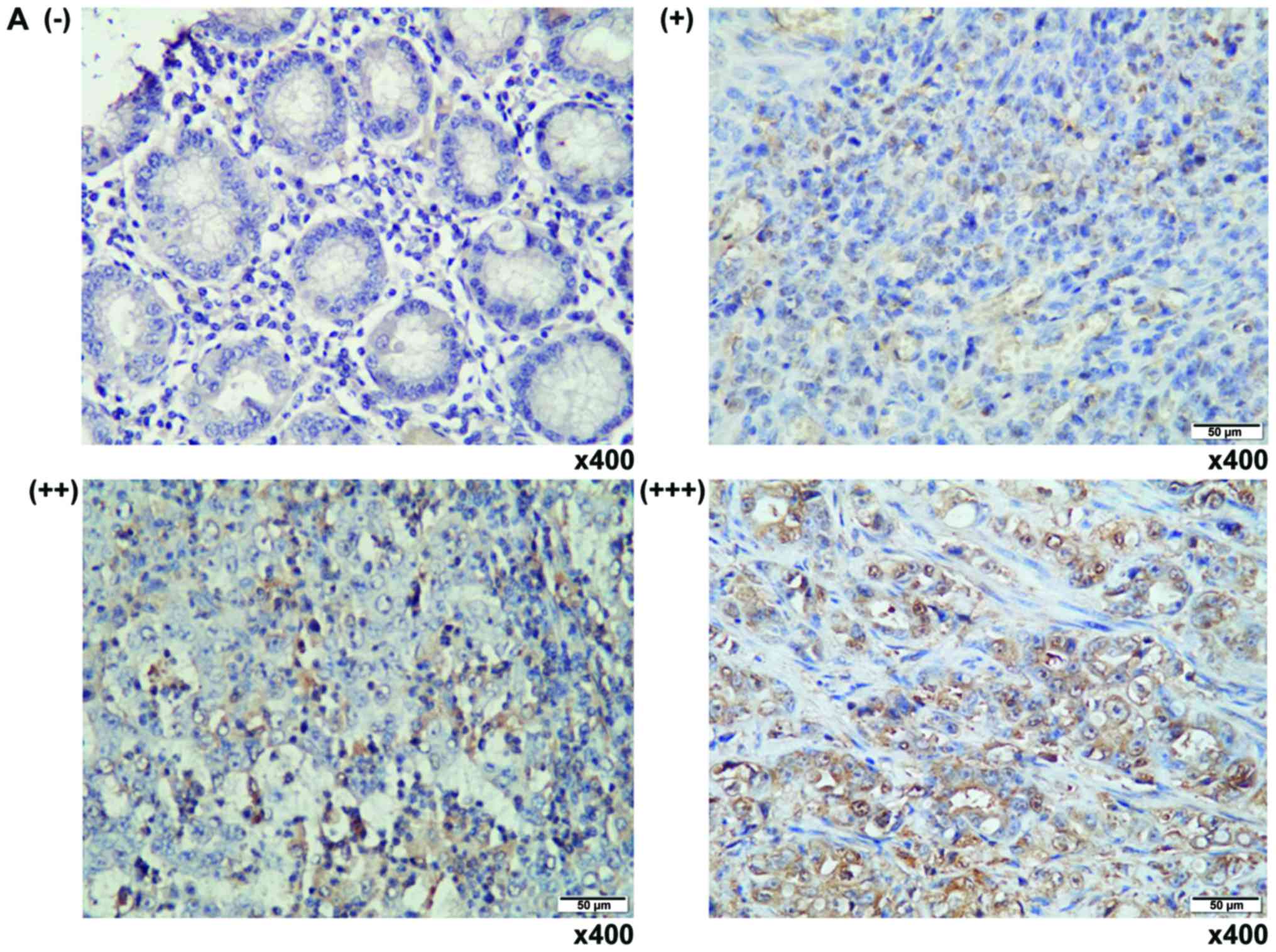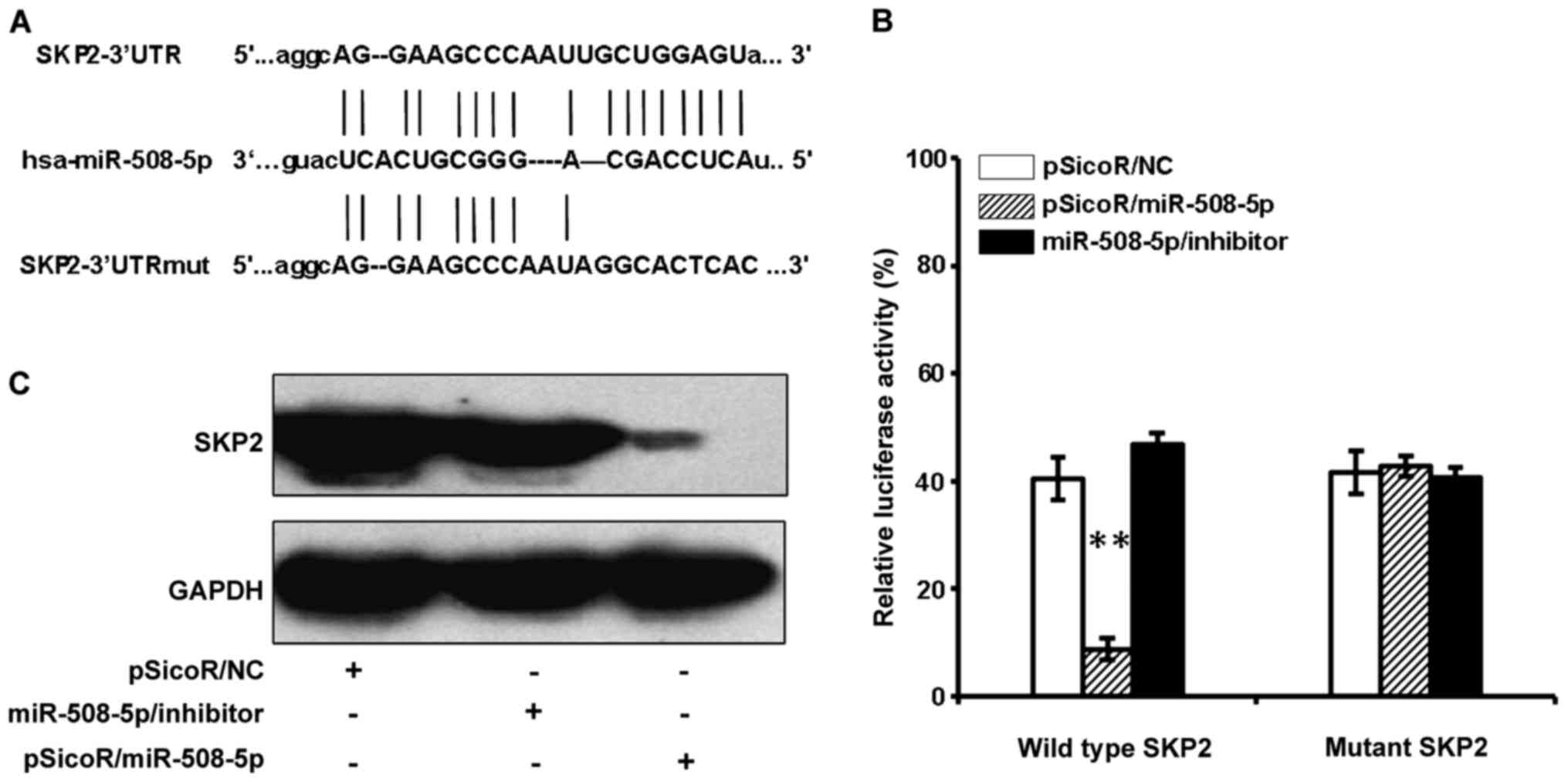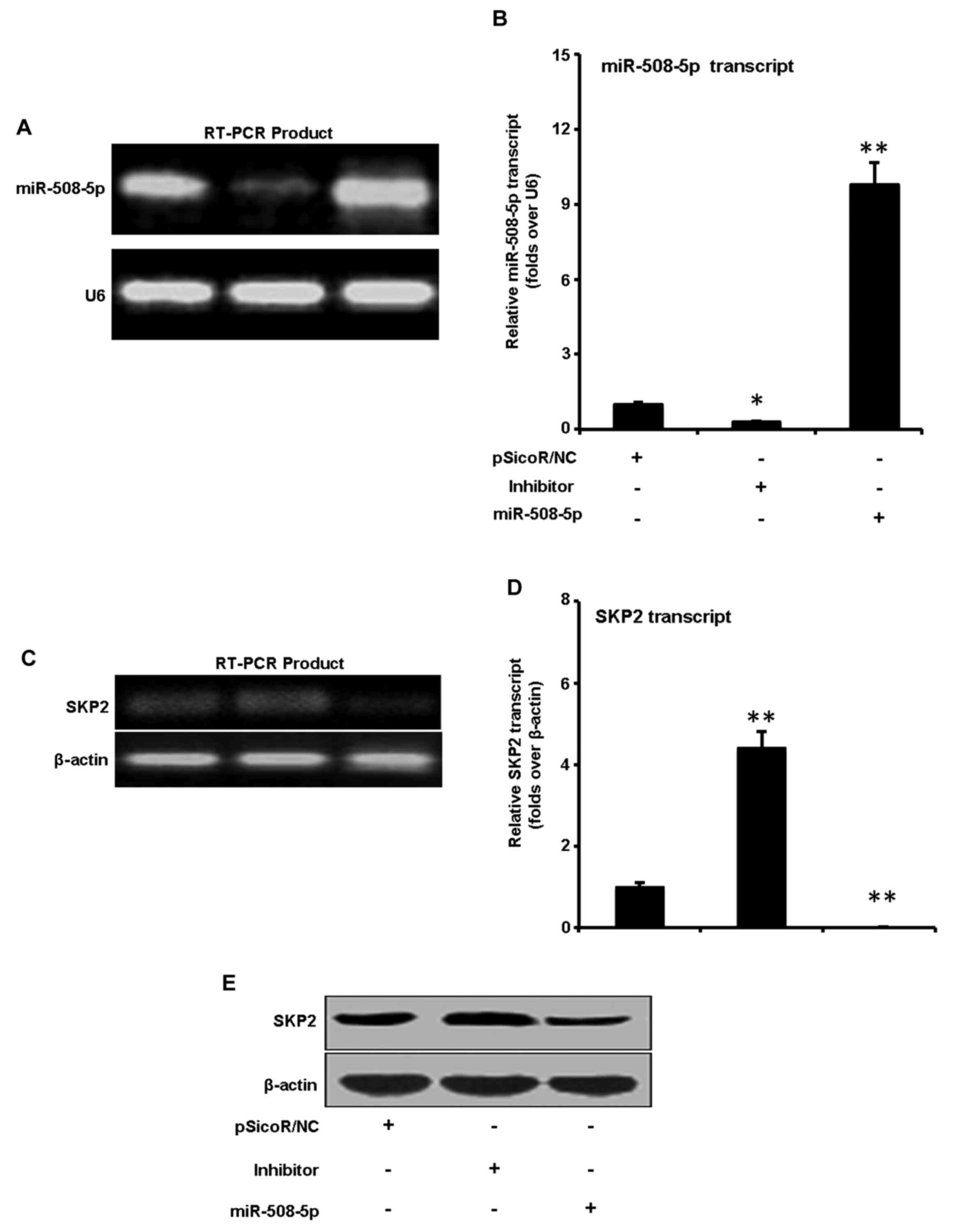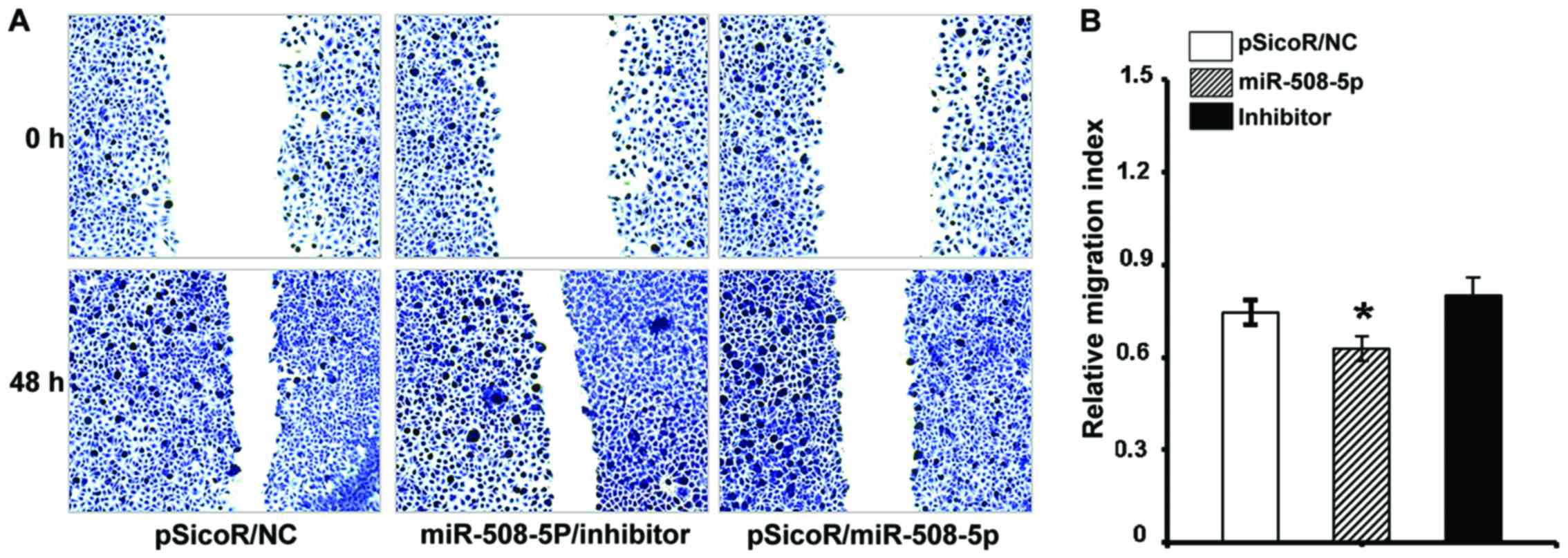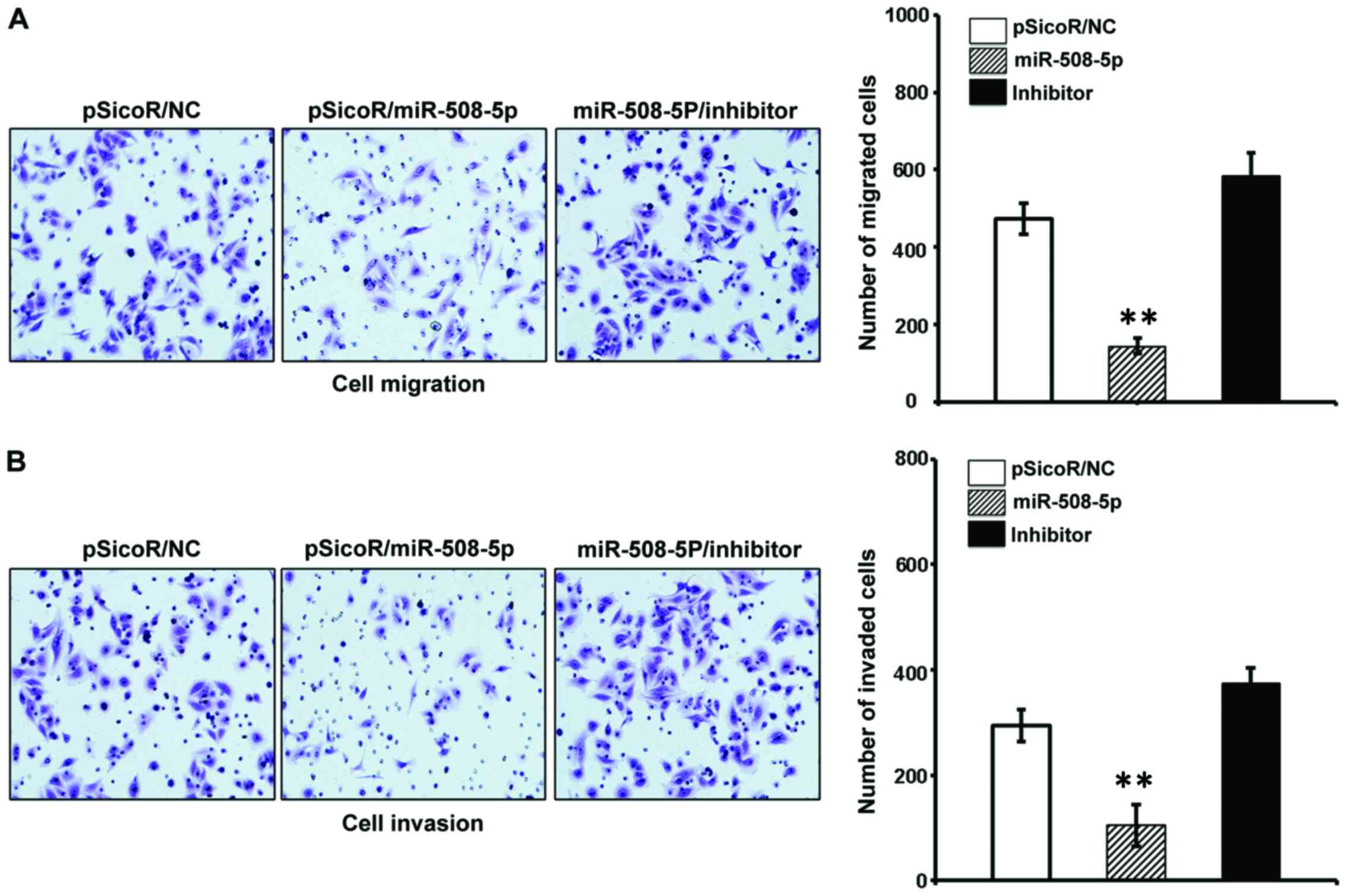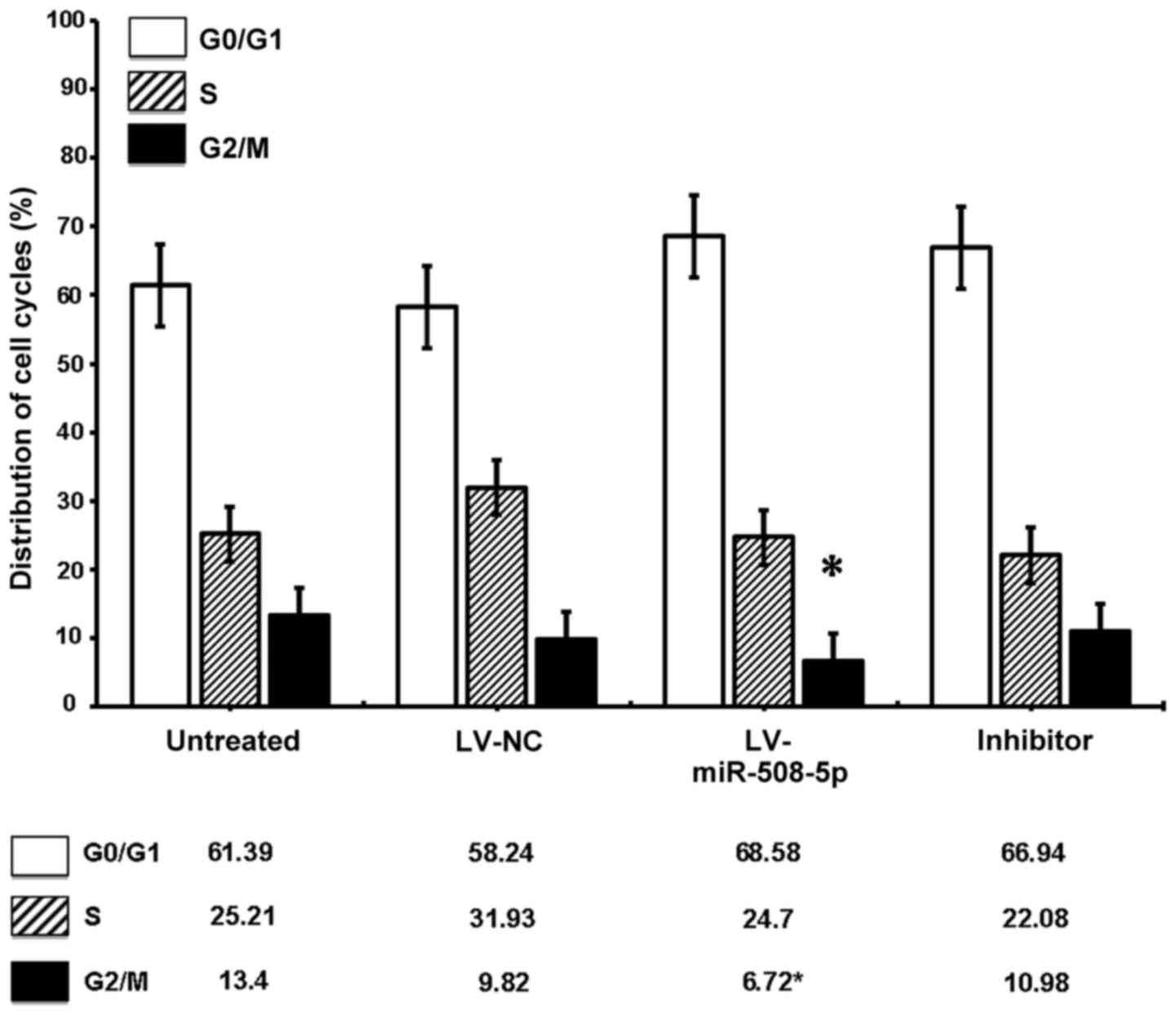MicroRNA-508-5p suppresses metastasis in human gastric cancer by targeting S-phase kinase‑associated protein 2
- Authors:
- Published online on: June 15, 2017 https://doi.org/10.3892/mmr.2017.6793
- Pages: 2163-2171
Abstract
Introduction
Gastric cancer (GC) is the 4th most commonly diagnosed cancer with poor clinical outcomes, which is the second leading cancer-related death worldwide, but the first leading cause of cancer death in China (1). Therefore, there is a need to develop novel agents for treatment of this type of cancer. Advances in high-throughput technologies have uncovered a flood of biomarkers and targets, and numerous of them have been under investigation for GC, including the S-phase kinase-associated protein 2 (SKP2) (2,3).
SKP2 is an F box protein that has been well-characterized as oncoprotein, which plays a crucial role in the development and progression of many cancers (4). It is involved in cell cycle progression and senescence, in which it acts as an Skp1-Cullin-1-F box (SCF) ubiquitin ligase substrate recognition factor, by which SKP2 is able to positively regulate the cell-cycle by targeting cell-cycle regulators and tumor suppressor proteins, including p27, for ubiquitin-mediated degradation (2,3). Mounting evidence has suggested that dysregulation of SKP2 expression is often associated with poor prognosis and metastasis in many types of cancer, including the breast cancer (5) and GC (6). Repression of SKP2 expression by RNAi or shRNA has shown a capability to inhibit the proliferation and migration of gallbladder carcinoma cells by enhancing p27 expression (7), and the growth and metastasis of gastric cancer MGC803 and SGC-7901 cells in vitro and in vivo (8). These studies implied that SKP2 was thus a potential therapeutic target for developing novel agents for treatment of cancers, including the GC (2–4,9,10).
MicroRNAs (miRNAs or miRs) are a class of endogenous non-coding single-stranded small RNAs of ~22 nucleotides, which have been demonstrated to play a crucial role in the regulation of gene expression at the post-transcriptional level, and function as either oncogenes or tumor suppressors in various cancers (11). Increasing evidence suggests that miRNAs are involved in the initiation, progression and metastasis of GC, in which they can function as oncomirs or tumor suppressor gene, i.e., some miRNAs are downregulated, while some are upregulated in GC (12,13). Li et al recently analyzed the miRNA profile in GC by a quantitative PCR assay and identified 22 differential expressed miRNAs, 6 of them were downregulated and might be tumor suppressors, the rest 16 miRNAs were upregulated and could be putative oncomirs (14). The miR-223 and miR-10a were further identified to correlate with the metastasis of GC (14,15). Most recently, Zhao et al identified miR-133b was a tumor suppressor in GC, in which miR-133b was downregulated, and an overexpression of miR-133b led a reduction of metastatic potential for GC cells by targeting Gli1 transcription factor (16). These studies clearly suggested that miRNAs were novel biomarkers for the diagnosis, prognosis and prediction of therapeutic efficacy of GC, and new targets for developing novel agents for treatment of this dreadful disease.
In the present study, we found that miR-508-5p was downregulated in GC, and an overexpression of miR-508-5p could inhibit the cell proliferation, and reduce the migration and invasion of GC cells by targeting SKP2 and induce cell-cycle arrest at G0/G1 phase.
Materials and methods
Ethics statement
Human gastric tissue was collected with a protocol approved by the Ethic Committee for the Conduct of Human Research at Ningxia Medical University. Written consent was obtained from every individual according to the Ethic Committee for the Conduct of Human Research protocol. All participants were over 18 years of age and provided written informed consent for the publication of the data. The Human Research Ethic Committee at Ningxia Medical University approved this study.
Human gastric tissue samples
Twelve tumor samples with histologic evidence of gastric adenocarcinoma and matched adjacent non-tumor tissues (close to adjacent tissues about 2 cm) were collected, ten gastric tissues diagnosed as antral or gastric inflammation and their adjacent tissues were archival samples from the Department of Medical Pathology, General Hospital of Ningxia Medical University (Table I). The pathologic tumor staging was determined according to the International Union Against Cancer (2009) (16).
Immunohistochemistry staining
The expression of SKP2 in clinic human GC and matched adjacent non-tumor tissues was evaluated by Immunohistochemistry (IHC) staining using mouse anti-human SKP2 antibody (1:100; Abgent Biotech Co., Ltd., Suzhou, China) as previously described (6,9,17,18). The expression of SKP2 protein was arbitrarily scored from -(<25% positive cells), +(25–50% positive cells), ++(50–75% positive cells) and +++(>75% positive cells), based on the intensity and number of positive cells by a single experienced pathologist (Table I).
Cell culture and transfection
Cell lines of human embryonic kidney 293 and human gastric cancer cell SGC-7901 were purchased from American Type Culture Collection (Mannasas, VA, USA). The cells were cultured and maintained at 37°C in a humidified atmosphere of 5% CO2 95% air in dulbecco's modified eagle medium (DMEM) supplemented with 10% fetal bovine serum (FBS) and 1% penicillin/streptomycin. Plasmid DNA transfection was performed using TransLipid Transfection Reagent (Beijing TransGen Biotech Co., Ltd., Beijing, China) per manufacturer's instruction.
Experimental validation of miR-508-5p target
In order to validate the SKP2 mRNA was a target of miR-508-5p, a reporter plasmid containing luciferase with the 3′UTR sequence of SKP2 mRNA was generated. The following primers were designed based on GenBank database (NM_001243120), and were used for amplification of wild-type and mutated 3′UTR of SKP2 mRNA: The sequence of common forward primer was 5′-CGACGCGTCGTTTATTGCAGGATGGTGT-3′, reverse primer for the wild-type of SKP2 mRNA 3′UTR was 5′-GACTAGTCAGAATGAAGGCAAAGGGA-3′, and the reverseec primer for mutated SKP2 mRNA 3′UTR was 5′-GACTAGTCACTCACGGATAACCCGAAGGACGGATAAAA-3′. The cDNA generated from SGC7901 RNA was used as templates for amplification of SKP2 3′UTR fragment by a PCR argeting SKP2 mRNA was ascertained by co-transfection plasmid DNA of pSicoR/massay as previously described (19,20). The specificity of miR-508-5p tiR-508-5p, miR-508-5p/inhibitor or pSicoR/NC and pMIR-Report/SKP2 or pMIR-Report/Mut-SKP2 into 293T cells and determined by the relative activity of firefly luciferase unit (RLU) at 48 h post-transfection using a dual-luciferase Reporter assay kit (Promega Corp., Madison, WI, USA). A Renilla luciferase expressing plasmid pRL-TK (Promega Corp.) was always included in the transfection to normalize the efficiency of each transftion.
Reverse transcription-quantitative PCR (RT-qPCR)
Total RNA from infected cells was isolated with a Miniprep kit, and small RNA was purified with an RNAiso kit per manufacturer's recommendations (Takara Bio, Dalian, China). Total RNA from archival paraffin sections was isolated using a Mag-Bind® FFPE RNA Kit (Omega Bio-Tek, Norcross, GA, USA). The sequence of primer set for amplification of miR-508-5p was 5′-ACACTCCAGCTGGGTACTCCAGAGGGCGTCACT-3′ (forward) and 5′-TGGTGTCGTGGAGTCG-3′ (reverse). The sequences of RT-PCR primer set for SKP2 was as: Forward primer 5′-TGTGACTGGTCGGTTGC-3′; reverse primer 5′-GGAGGGTGGACACTTCTAT-3′. The RT-qPCR was performed using a Bio-Rad iQ5 lightcycler using a TaKaRa SYBR RT-PCR kit (Takara Bio). Relative expression was calculated as previously described using real-time PCR efficiencies and the crossing point deviation of unknown sample vs. control using the ΔΔCq method (21).
Generation and infection of lentiviral vector expressing miR-508-5p
In order to construct a lentiviral vector expressing miR-508-5p, oligonucleotides of sense strand (5′-TTACTCCAGAGGGCGTCACTCATGTTCAAGAGACATGAGTGACGCCCTCTGGAGTATTTTTTC-3) and antisense strand (5′-TCGAGAAAAAATACTCCAGAGGGCGTCACTCATCTCTCTTGAACATGAGTGACGCCCTCTGGAGTAA-3′) were synthesized, which were based on the sequence of human miR-508-5p (MIMAT0004778: 5′-UACUCCAGAGGGCGUCACUCAUG-3′) from miRBase database. Restriction endonuclease HpaI and XhoI were introduced at 5′-ends of these oligonucleotides, respectively. The miR-508-5p precursor was modified with appropriate restriction enzymes, and cloned into a miRNA expressing plasmid, pSicoR (Department of Biological Chemistry, School of Medicine, Fudan University, Shanghai, China) to generate the vector expressing miR-508-5p, which was designated as pSicoR/miR-508-5p in this study. Using the same approch, a negative control vector was also generated, the primer of miR-508 −5p/inhibitor was 5′-CAUGAGUGACGCCCUCUGGAGUA-3′.
For production of the lentiviral vector, the proviral plasmid (1.5 µg) was co-transfected with packaging plasmids pCMV-VSV-G (0.5 µg) and pCMV-dR8.91 (1 µg) (Department of Biological Chemistry) with TransLipid Transfection Reagent as suggested by the manufacturer. The medium was replaced with 2 ml of DMEM/10% FBS at 6 h post transfection. The viral particles were titrated in 293T cells by counting EGFP-positive cells. SGC7901 cells were infected with vector-containing supernatant directly after 1 day in culture, which was designated as LV-miR-508-5p, LV-NC and inhibitor.
Western blot analysis
Whole cell lysates (75 µg) were prepared in a lysis buffer, and were resolved by a 10% sodium dodecyl sulfate-polyacrylamide gel (SDS-PAGE), followed by being transferred to a PVDF membrane (Millipore Corp., Billerica, MA, USA). The membranes were probed with mouse anti-SKP2 antibody and anti-GAPDH antibody (Boster, Wuhan, China) were for the interested protein SKP2 and endogenous GAPDH for loading control, respectively. The blots were developed using the enhanced chemiluminescence (ECL) reagent (Advansta Inc., Menlo Park, CA, USA) after they were incubated with the appropriate peroxidase labeled secondary antibodies.
MTT assay
Cell proliferation was determined by using the MTT cell proliferation kit (Solarbio, Beijing, China). 5×103 of SGC 7901 cells were seeded in each 96-well plate and allowed to adhere overnight. The cells were then infected with lentiviral vector for the indicated times prior to they were used for MTT assay per the manufacturer's instruction (Bio-Rad Laboratories, Inc., Irvine, CA, USA).
Assay of Hoechst staining
For the preparation of Hoechst staining, SGC 7901 cells were plated with 1×105 cells/ml in 6-well plates. The cells were infected with lentiviral vectors for directly stained with Hoechst kit from Beyotime Institute of Biotechnology (Shanghai, China). The nuclear morphology was observed under a fluorescent microscope (Leica, Mannheim, Germany).
Cell scratch assay
The SGC-7901 cells were seeded at 80% confluent and infected with lentiviral vectors for 48 h (cells were grown to confluence) in 6-well culture plates. The cells were then scratched with 200 ml pipette tips. The resultant unattached cells were removed by washing with pre-warmed PBS for three times, the wounded monolayers were cultured for additional 48 h prior to be stained with 0.1% crystal violet solution. The closure of the wounded areas was observed under a microscope at ×40 magnification (Leica) and photographed. The distance of closure was quantified with the NIH Image J image processing program. These experiments were performed in triplicate. Each condition was tested in duplicate and each experiment was repeated at least three times.
Transwell assay
Transwell assay was used for accessing the migration and invasion of cells. For cell migration, 2×104 lentiviral infected cells suspended in serum-free medium were seed on onto uncoated 8-µm transwell filter inserts (Corning Inc., Corning, NY, USA) of 24-well plates in duplicate. The lower chambers contained 500 µl medium containing 10% FBS as a chemoattractant and cultured for additional 24 h. For the invasion assay, the inserts were previously coated with Matrigel (BD Biosciences, Bedford, MA, USA) and cultured for 48 h. At the end of the experiments, the cells in the upper chamber were removed with a cotton swab, and the cells on the lower surface were fixed and stained with 0.1% crystal violet solution. Cells of three randomly visual fields of each insert were counted under a light microscope. Each condition was tested in duplicate and each experiment was repeated for three times.
Flow cytometry assay
The apoptosis and cell cycle were determined by a flow cytometry assay. SGC-7901 cells were infected with various lentiviral vectors prior to be collected and stained with Annexin V and PI using an Apoptosis Detection kit I (BD Pharmigen, San Jose, CA, USA) for flow cytometry analysis. The flow cytometry analysis was performed on a BD FACSCanto II, and data was analyzed with FlowJo 8.8.6 software (Tree Star Inc, Ashland, OR, USA). All experiments were performed with biological triplicates and data are representative of at least three independent experiments.
Statistical analysis
All data collected in this study was obtained from at least three independent experiments for each condition. SPSS 17.0 analysis software (SPSS, Inc., Chicago, IL, USA) and PRISM 5 (GraphPad Software, Inc., La Jolla, CA, USA) were used for the statistic analysis. Statistical evaluation of the data was performed by one-way ANOVA when more than two groups were compared with a single control, and t-test for comparison of differences between the two groups. Significant differences were assigned to P<0.05, P<0.01 and P<0.0001 denoted by *, ** and ***, respectively. Data was presented as the mean ± standard deviation (SD).
Results
SKP2 is upregulated in human gastric adenocarcinoma
Since SKP2 expression is positively correlated with poor prognosis and metastasis in many cancers, including the GC (6). To further interrogate clinical relevance of SKP2 with the pathogenesis in human GC, its expression was first evaluated in GC tumor tissues and the adjacent non-tumor tissues by IHC staining against anti-SKP2 antibody. IHC staining displayed a predominantly nuclear staining of SKP2 (Fig. 1A). Notably, the expression of SKP2 was strikingly provoked with the malignant stages of tumors from the twelve examined archival GC samples, relative to the adjacent non-tumor tissues and antral or inflammatory gastric tissues (Fig. 1B), supporting the previous findings of that SKP2 was an important signaling molecule that plays an oncogenic role in the carcinogenesis of GC, and an attractive potential target for treatment of this disease (6,8,17).
miR-508-5p is downregulated in human GC
Previous miRNA microarray analysis has demonstrated a downregulation of miR-508-5p in many cancers, including the GC (22–24). In order to further validate a correlation of the expression of miR-508-5p and clinicopathologic stages of GC, the relative expression of miR-508-5p in tissues of various stages of GC, antral and grastric inflammation was evaluated by a RT-qPCR assay (Fig. 1B and Table I). The results revealed an inverse correlation of miR-508-5p transcripts with the progression of GC (Table I); miR-508-5p was dramatically downregulated in GC relative to other non-cancer gastric disorders (Fig. 1B and Table I).
SKP2 mRNA is a target of miR-508-5p
In order to identify the biological significances of miR-508-5p in GC, the online computational miRNA target prediction tool, TargetScan, was used to identify potential targets of miR-508-5p. The SKP2 was thus identified as a candidate target of miR-508-5p by virtue of possessing several seed sequences of miR-508-5p within the 3′UTR of their mRNA. To experimentally validate whether SKP2 is a potential target of miR-508-5p in GC. Luciferase reporter vector containing a 3′UTR of SKP2 mRNA (pMIR-Report/SKP2 3′UTR), or a mutated 3′UTR (pMIR-Report/Mut-SKP2 3′UTR) were first constructed (Fig. 2A). The 293T cells were co-transfected with pMIR-Report/SKP2 3′UTR or pMIR-Report/Mut-SKP2 3′UTR, and proviral plasmid pSicoR/NC, pSicoR/miR-508-5p, miR-508-5p/inhibitor. The results of dual luciferase assay showed a significant decrease and increase of relative luciferase activity in the cells transfected with pSicoR/miR-508-5p, miR-508-5p/inhibitor, respectively, in comparison with the pSicoR/NC transfected cells (Fig. 2B). There was no significant change of luciferase activity in the cells transfected with pSicoR/NC or pMIR-Report/Mut-SKP2 3′UTR plasmid DNA (Fig. 2B). Immunoblotting assay further confirmed that the endogenous SFP2 protein was also strikingly suppressed in the 293T cells transfected with pSicoR/miR-508-5p (Fig. 2C). This data indicated that SKP2 might be a potential target for tumor suppressor miR-508-5p in GC.
miR-508-5p represses SKP2 expression in GC SGC-7901 cells
We next sought to explore the capacity of miR-508-5p to regulate SKP2 in GC. SGC-7901 cells were infected with LV-NC, LV-miR-508-5p, inhibitor vectors. Although miR-508-5p transcript was detected in GC SGC-7901 cells, a significant augmentation and inhibition of miR-508-5p transcript were observed in cells infected with LV-miR-508-5p, inhibitor vectors as determined by a qRT-PCR assay, in comparison with the cells infected with LV-NC, respectively (Fig. 3A and B). The total cell lysates were harvested for immunoblotting analysis against anti-SKP2 antibody at 48 h post infection. The result demonstrated that the expression of SKP2 was downregulated and upregulated at both mRNA (Fig. 3C and D) and protein levels (Fig. 3E) in cells infected with LV-miR-508-5p, inhibitor vectors, as compared with the LV-NC, respectively. These results suggested that miR-508-5p was capable of downregulating SKP2 expression in GC cells at both of transcriptional and post-transcriptional levels, indicative of an underlying mechanism of miR-508-5p in carcinogenesis of GC.
miR-508-5p arrests the SGC-7901 cell proliferation by promoting cell apoptosis
To better characterize the functionality of miR-508 in GC cell proliferation, the SGC-7901 cells were infected with LV-NC, LV-miR-508-5p, or inhibitor vectors, the cell proliferation and apoptosis was determined by an MTT, Hoechst staining and flow cytometric assays. The infection of LV-miR-508-5p showed a significant reduction of cell proliferation, in comparison with those infected with LV-NC and inhibitor at 72 h post-infection (P<0.05), as determined by an MTT assay (Fig. 4A). Flow cytometry analysis further demonstrated an increased frequency of apoptosis cells in the SGC-7901 cells infected with LV-miR-508-5p, in comparison with those infected with LV-NC (P<0.01) (Fig. 4B); and an increased abundance of cells with characteristics of chromosome condensation was also found in the cells infected with LV-miR-508-5p (Fig. 4C and D).
miR-508-5p inhibits SGC-7901 cell migration and invasion in vitro
The aforementioned result of inverse relationship between miR-508-5p and clinical pathogenesis of GC led us to investigate the impact of miR-508-5p in the metastasis of GC by a cell scratch assay and a transwell assay in vitro. The migration capacity in the SGC-7901 cells infected with LV-miR-508-5p was significantly reduced, as compared with those infected with LV-NC or inhibitor, as determined by both of scratch assay (Fig. 5) and transwell assay (Fig. 6A) (P<0.05 and P<0.01, respectively). In addition, the ability of invasion through the Matrigel was also dramatically decreased in the SGC-7901 cells overexpressed miR-508-5p, in comparison with the controls (P<0.01) (Fig. 6B).
miR-508-5p regulates SGC-7901 cell cycle progression
Since the SKP2 was a regulator of cell cycle, we next sought to determine whether the miR-508-5p regulated the cell cycle of GC cells in vitro. Flow cytometric assay demonstrated a significantly decreased G2/M phase cell fraction in LV-miR-508-5p cells, as compared with the controls (P<0.05) (Fig. 7). Of interest, an overexpression of miR-508-5p also showed a trend toward cell arrest at G0/G1 phase (Fig. 7). These data suggested that miR-508-5p was capable of regulating SGC-7901 cell cycle progression by inducing cell cycle arrest at the G0/G1 phase in part through a mechanism of targeting SKP2.
Discussion
Increasing evidence has suggested that miRNAs play crucial roles in the development and progression of human GC. In the present study, we identified miR-508-5p was a potential tumor suppressor in GC. miR-508-5p was significantly downregulated in GC, which was correlated with the progression and malignance of GC. Overexpression of miR-508-5p showed an ability to promote cell apoptosis, inhibit the migration and invasion of GC cells in vitro, and induce cell cycle arrest at G0/G1 phase by directly targeting SKP2.
SKP2 has been demonstrated as a key factor for progression of cell from G to S phase by regulating cell cycle progression in Gl/S and G2/M phases, through a ubiquitin-dependent p27 degradation pathway (25). In this regards, SKP2 could interrupt cell cycle progression, and thus were involved in the cell proliferation, apoptosis, tumorigenesis and malignant transformation, by ubiquitin-dependent degradation of a variety of target proteins (7). SKP2 can function as an oncoprotein that plays a crucial role in the development and progression of many cancers (4). Several studies have revealed that the expression of SKP2 was evoked in human gastrointestinal cancers, which was inversely correlated with p27 protein level, and positively associated with the progression of the cancer (6,26,27). SKP2 is thus a potential target of developing novel agents for treatment of cancers (3,4,28). In agreement with these findings, the IHC result in the present study also showed an augmented SKP2 protein expression in human GC mucosal tissues, which was correlated with a reduced expression of miR-508-5p transcript and the progression of the cancers.
miRNAs have been demonstrated to play roles in development of GC (14,16,19,29–31). For instance, Yao et al recently identified miR-146a acted as a tumor suppressor by directly targeting WASF2 in GC (32). Mounting evidence suggested that miRNAs could directly or indirectly regulate SKP2 by targeting various genes. Consistent with this finding, we interestingly identified which the miR-508-5p was able to exert a role of tumor suppressor in GC by targeting SKP2. An overexpression of miR-508-5p was able to downregulate SKP2 expression at both transcriptional and post-transcriptional levels, repress GC cell migration and invasion, and inhibit GC cell proliferation by inducing cell cycle arrest at the G0/G1 phase. Such miRNA-regulated cell cycle arrest was also reported by other group (25,33). Thus, a downregulation of SKP2 may inhibit cell proliferation and induce cell cycle arrest at G0/G1 phase.
miR-508-5p has been demonstrated to be involved in chronic heart failure (CHF) and several types of cancer, including the GC (22–24,34). These datas suggested miR-508-5p could be a useful target for the diagnosis, prevention and treatment of CHF (34). In human GC, miR-508-5p was found to be downregulated in lymph node metastatic tissues, relative to the primary tumor tissue of GC (23); overexpression of miR-508-5p was capable of reversing GC cell resistance to multiple chemotherapeutics in vitro and sensitizing tumors to chemotherapy in vivo (22). Together with the findings in this study, the results concluded that a miR-508-5p played a critical role in the tumorigenesis of GC, and could be served as a prognostic factor for overall survival, drug resistance prediction and treatment in gastric cancer.
Recently, Zhao et al found miR-133b was downregulated in human GC, and overexpression of miR-133b reduced the metastatic capacity of GC cells by directly targeting Gli1 transcription factor (16). In line with this finding, we also observed reduced the abilities of invasion and migration in SGC-7901 cells after over-expressed miR-508-5p by both scratch and transwell assays. Previous study has demonstrated that SKP2 binding sites resided in Sp1 promoter region (20), and the Sp1 gene could regulate the expressions of MMP2 and MMP9, consequently influence the potentials of cell invasion and migration. Therefore, a downregulation of SKP2 may also inhibit the Sp1 activity, and sequentially reduce the metastatic ability of GC cells.
Collectively, abundant SKP2 protein was detected in GC tissues, accompanied with striking downregulation of miR-508-5p in GC. An overexpression of miR-508-5p exhibited an ability to promote cell apoptosis, reduce metastatic potentials in vitro, and induce cell cycle arrest at G0/G1 phase through a mechanism by which the miR-508-5p directly target SKP2. We thus identified miR-508-5p as a tumor suppressor in GC, which warranted for further investigation as a novel target for prognosis, prevention and treatment of this disease.
Acknowledgements
This study was supported by grants from the Natural Science Foundation of China (no. 81460368), the Ningxia High Education Science and Technology important project (2014, no. 2014–70), and the Science and Technology program of Ningxia (2013).
References
|
Yang L: Incidence and mortality of gastric cancer in China. World J Gastroenterol. 12:17–20. 2006. View Article : Google Scholar : PubMed/NCBI | |
|
Chan CH, Li CF, Yang WL, Gao Y, Lee SW, Feng Z, Huang HY, Tsai KK, Flores LG, Shao Y, et al: The Skp2-SCF E3 ligase regulates Akt ubiquitination, glycolysis, herceptin sensitivity, and tumorigenesis. Cell. 149:1098–1111. 2012. View Article : Google Scholar : PubMed/NCBI | |
|
Pascal LE and Wang Z: Virtual drug design: Skp1-Skp2 inhibition targets cancer stem cells. Asian J Androl. 15:717–718. 2013. View Article : Google Scholar : PubMed/NCBI | |
|
Wang Z, Gao D, Fukushima H, Inuzuka H, Liu P, Wan L, Sarkar FH and Wei W: Skp2: A novel potential therapeutic target for prostate cancer. Biochim Biophys Acta. 1825:11–17. 2012.PubMed/NCBI | |
|
Sonoda H, Inoue H, Ogawa K, Utsunomiya T, Masuda TA and Mori M: Significance of skp2 expression in primary breast cancer. Clin Cancer Res. 12:1215–1220. 2006. View Article : Google Scholar : PubMed/NCBI | |
|
Ma XM, Liu Y, Guo JW, Liu JH and Zuo LF: Relation of overexpression of S phase kinase-associated protein 2 with reduced expression of p27 and PTEN in human gastric carcinoma. World J Gastroenterol. 11:6716–6721. 2005. View Article : Google Scholar : PubMed/NCBI | |
|
Zhang B, Ji LH, Liu W, Zhao G and Wu ZY: Skp2-RNAi suppresses proliferation and migration of gallbladder carcinoma cells by enhancing p27 expression. World J Gastroenterol. 19:4917–4924. 2013. View Article : Google Scholar : PubMed/NCBI | |
|
Wei Z, Jiang X, Liu F, Qiao H, Zhou B, Zhai B, Zhang L, Zhang X, Han L, Jiang H, et al: Downregulation of Skp2 inhibits the growth and metastasis of gastric cancer cells in vitro and in vivo. Tumor Biol. 34:181–192. 2013. View Article : Google Scholar | |
|
Tian YF, Chen TJ, Lin CY, Chen LT, Lin LC, Hsing CH, Lee SW, Sheu MJ, Lee HH, Shiue YL, et al: SKP2 overexpression is associated with a poor prognosis of rectal cancer treated with chemoradiotherapy and represents a therapeutic target with high potential. Tumour Biol. 34:1107–1117. 2013. View Article : Google Scholar : PubMed/NCBI | |
|
Lv A, Li Z, Tian X, Guan X, Zhao M, Dong B and Hao C: SKP2 high expression, KIT exon 11 deletions, and gastrointestinal bleeding as predictors of poor prognosis in primary gastrointestinal stromal tumors. PLoS One. 8:e62912013. View Article : Google Scholar | |
|
Manikandan J, Aarthi JJ, Kumar SD and Pushparaj PN: Oncomirs: The potential role of non-coding microRNAs in understanding cancer. Bioinformation. 2:330–334. 2008. View Article : Google Scholar : PubMed/NCBI | |
|
Gao M, Yin H and Fei ZW: Clinical application of microRNA in gastric cancer in Eastern Asian area. World J Gastroenterol. 19:2019–2027. 2013. View Article : Google Scholar : PubMed/NCBI | |
|
Zhao X, Li X and Yuan H: microRNAs in gastric cancer invasion and metastasis. Front Biosci (Landmark Ed). 18:803–810. 2013. View Article : Google Scholar : PubMed/NCBI | |
|
Li X, Zhang Y, Zhang H, Liu X, Gong T, Li M, Sun L, Ji G, Shi Y, Han Z, et al: miRNA-223 promotes gastric cancer invasion and metastasis by targeting tumor suppressor EPB41L3. Mol Cancer Res. 9:824–833. 2011. View Article : Google Scholar : PubMed/NCBI | |
|
Chen W, Tang Z, Sun Y, Zhang Y, Wang X, Shen Z, Liu F and Qin X: miRNA expression profile in primary gastric cancers and paired lymph node metastases indicates that miR-10a plays a role in metastasis from primary gastric cancer to lymph nodes. Exp Ther Med. 3:351–356. 2012.PubMed/NCBI | |
|
Zhao Y, Huang J, Zhang L, Qu Y, Li J, Yu B, Yan M, Yu Y, Liu B and Zhu Z: MiR-133b is frequently decreased in gastric cancer and its overexpression reduces the metastatic potential of gastric cancer cells. BMC Cancer. 14:342014. View Article : Google Scholar : PubMed/NCBI | |
|
Wei Z, Jiang X, Qiao H, Zhai B, Zhang L, Zhang Q, Wu Y, Jiang H and Sun X: STAT3 interacts with Skp2/p27/p21 pathway to regulate the motility and invasion of gastric cancer cells. Cell Signal. 25:931–938. 2013. View Article : Google Scholar : PubMed/NCBI | |
|
Hung WC, Tseng WL, Shiea J and Chang HC: Skp2 overexpression increases the expression of MMP-2 and MMP-9 and invasion of lung cancer cells. Cancer Lett. 288:156–161. 2010. View Article : Google Scholar : PubMed/NCBI | |
|
Tong F, Cao P, Yin Y, Xia S, Lai R and Liu S: MicroRNAs in gastric cancer: From benchtop to bedside. Dig Dis Sci. 59:24–30. 2014. View Article : Google Scholar : PubMed/NCBI | |
|
Tapias A, Ciudad CJ, Roninson IB and Noe V: Regulation of Sp1 by cell cycle related proteins. Cell Cycle. 7:2856–2867. 2008. View Article : Google Scholar : PubMed/NCBI | |
|
Pfaffl MW: A new mathematical model for relative quantification in real-time RT-PCR. Nucleic Acids Res. 29:e452001. View Article : Google Scholar : PubMed/NCBI | |
|
Shang Y, Zhang Z, Liu Z, Feng B, Ren G, Li K, Zhou L, Sun Y, Li M, Zhou J, et al: miR-508-5p regulates multidrug resistance of gastric cancer by targeting ABCB1 and ZNRD1. Oncogene. 33:3267–3276. 2014. View Article : Google Scholar : PubMed/NCBI | |
|
Wang Z, Wang J, Yang Y, Hao B, Wang R, Li Y and Wu Q: Loss of has-miR-337-3p expression is associated with lymph node metastasis of human gastric cancer. J Exp Clin Cancer Res. 32:762013. View Article : Google Scholar : PubMed/NCBI | |
|
Yan H, Wang S, Yu H, Zhu J and Chen C: Molecular pathways and functional analysis of miRNA expression associated with paclitaxel-induced apoptosis in hepatocellular carcinoma cells. Pharmacology. 92:167–174. 2013. View Article : Google Scholar : PubMed/NCBI | |
|
Lonjedo M, Poch E, Mocholí E, Hernández-Sánchez M, Ivorra C, Franke TF, Guasch RM and Pérez-Roger I: The Rho family member RhoE interacts with Skp2 and is degraded at the proteasome during cell cycle progression. J Biol Chem. 288:30872–30882. 2013. View Article : Google Scholar : PubMed/NCBI | |
|
Fukuchi M, Masuda N, Nakajima M, Fukai Y, Miyazaki T, Kato H and Kuwano H: Inverse correlation between expression levels of p27 and the ubiquitin ligase subunit Skp2 in early esophageal squamous cell carcinoma. Anticancer Res. 24:777–783. 2004.PubMed/NCBI | |
|
Harada K, Kawaguchi S Supriatno, Kawashima Y, Itashiki Y, Yoshida H and Sato M: High expression of S-phase kinase-associated protein 2 (Skp2) is a strong prognostic marker in oral squamous cell carcinoma patients treated by UFT in combination with radiation. Anticancer Res. 25:2471–2475. 2005.PubMed/NCBI | |
|
Wei S, Chu PC, Chuang HC, Hung WC, Kulp SK and Chen CS: Targeting the oncogenic E3 ligase Skp2 in prostate and breast cancer cells with a novel energy restriction-mimetic agent. PLoS One. 7:e472982012. View Article : Google Scholar : PubMed/NCBI | |
|
He W, Li Y, Chen X, Lu L, Tang B, Wang Z, Pan Y, Cai S, He Y and Ke Z: miR-494 acts as an anti-oncogene in gastric carcinoma by targeting c-myc. J Gastroenterol Hepatol. 29:1427–1434. 2014. View Article : Google Scholar : PubMed/NCBI | |
|
Liu T, Tang H, Lang Y, Liu M and Li X: MicroRNA-27a functions as an oncogene in gastric adenocarcinoma by targeting prohibitin. Cancer Lett. 273:233–242. 2009. View Article : Google Scholar : PubMed/NCBI | |
|
Takagi T, Iio A, Nakagawa Y, Naoe T, Tanigawa N and Akao Y: Decreased expression of microRNA-143 and −145 in human gastric cancers. Oncology. 77:12–21. 2009. View Article : Google Scholar : PubMed/NCBI | |
|
Yao Q, Cao Z, Tu C, Zhao Y, Liu H and Zhang S: MicroRNA-146a acts as a metastasis suppressor in gastric cancer by targeting WASF2. Cancer Lett. 335:219–224. 2013. View Article : Google Scholar : PubMed/NCBI | |
|
Sanchez N, Gallagher M, Lao N, Gallagher C, Clarke C, Doolan P, Aherne S, Blanco A, Meleady P, Clynes M and Barron N: MiR-7 triggers cell cycle arrest at the G1/S transition by targeting multiple genes including Skp2 and Psme3. PLoS One. 8:e656712013. View Article : Google Scholar : PubMed/NCBI | |
|
Qiang L, Hong L, Ningfu W, Huaihong C and Jing W: Expression of miR-126 and miR-508-5p in endothelial progenitor cells is associated with the prognosis of chronic heart failure patients. Int J Cardiol. 168:2082–2088. 2013. View Article : Google Scholar : PubMed/NCBI |



